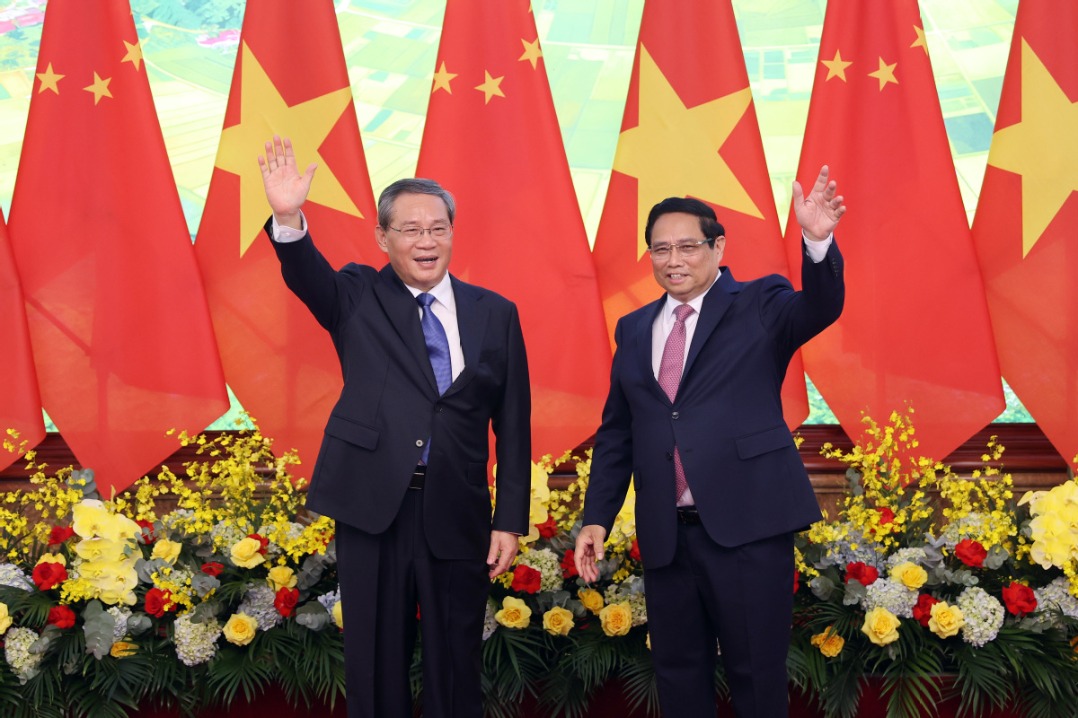China's exports showing remarkable resilience despite headwinds
By Xun Yugen, Liang Zhonghua and Li Jun | China Daily | Updated: 2024-10-14 09:37

China's export performance has remained robust despite the restructuring of global industrial supply chains and the overall economic downturn, indicating the continued advantages of the country's manufacturing sector.
China's export share to the Association of Southeast Asian Nations has risen significantly, surpassing both Europe and the United States to become China's largest export destination.
While China's trade ties with ASEAN, as well as ASEAN's linkages with the United States, have been steadily deepening, there is no obvious evidence of China using ASEAN as a transit route to the US market.
China's export performance has demonstrated remarkable resilience, with outbound shipments staging a sustained recovery since August 2023 and turning positive in November of that year.
The nation's export growth rate reached 8.7 percent as of August 2024, the highest level since March 2023, with the cumulative year-on-year increase rising to 4.6 percent.
When factoring out price effects, China's actual export volume has performed even better, clearly outpacing the pre-pandemic growth trend line.
Notably, China has achieved this impressive export performance against the backdrop of a global economic downturn, underscoring the inherent advantages of the country's manufacturing production capabilities.
China's export share to ASEAN has been steadily rising since 2018, with particularly rapid increases seen between 2018-2020 and the mid-2022 to mid-2023 period.
As of August 2024, China's export share to ASEAN reached 16.7 percent, a 4.4 percentage points increase from the end of 2017. This has allowed ASEAN to surpass Europe and the US as China's top export destination since the beginning of 2023.
In contrast, China's export shares to Europe and the US have declined to 14.8 percent and 14.1 percent respectively, down 1.9 and 4.9 percentage points from the end of 2017.
The trend is also reflected in export growth rates. China's exports to ASEAN grew by 4.8 percent as of August 2024, significantly outperforming the — 3.7 percent and — 1 percent growth rates recorded for exports to Europe and the US during the same period.
As China and the US undergo industrial chain restructuring in the wake of the 2018 trade tensions, ASEAN has emerged as a major beneficiary, significantly boosting its exports to the US market.
However, an analysis of the trade data indicates that China is not using ASEAN as a conduit to re-export goods to the US market.
From the US perspective, its reliance on imports from China has been steadily declining since 2018. As of July 2024, China's share of US imports had dropped below 14 percent, a reduction of around 8 percentage points from the previous peak.
Meanwhile, US import dependence on ASEAN has risen to over 10 percent, an increase of more than 3 percentage points since 2018. The fastest phase of the increase in the US import share from ASEAN was from the beginning of 2019 to the beginning of 2021, which can explain 86 percent of the total change.
In contrast, the most rapid declines in the US import share from China occurred during 2018 to the end of 2019, and mid-2021 to July 2024, accounting for around 70 percent of the overall change. This does not align with the positive trajectory of ASEAN's exports.
An analysis of trade data from the ASEAN perspective also indicates that the bloc's growing exports to the US are not serving as a conduit for Chinese goods.
ASEAN's share of US imports has been on a steady upward trend since 2012, reaching 15.3 percent as of June 2024, surpassing China's share of 14.1 percent.
However, the fastest phases of the increase in ASEAN's export share to the US were from 2014-2017 and 2018 to mid-2021. In contrast, the period from mid-2021 to June 2024 had actually seen ASEAN's US export share remain relatively stable.
Meanwhile, the most rapid declines in China's US export share occurred from the end of 2018 to mid-2020, as well as the third quarter of 2022 to August 2024 — the latter of which can explain over 60 percent of the reduction in China's US export share. This does not align with ASEAN's performance.
A closer examination of the trade products exchanged between China, ASEAN and the United States further confirms that China is not using the ASEAN region as a conduit to re-export goods to the US market.
Prior to the 2018 China-US trade tensions, China's top exports to the US included products like mobile phones, automatic data processing equipment, monitors, motor vehicle parts, furniture, tricycles, and luggage, with the top 3 finished goods accounting for 23.5 percent of the total.
In 2023, China's key export products to the US remained mobile phones and automatic data processing equipment, but low-value, easy-clearance goods had risen to the third position.
Compared to 2017, the combined share of mobile phones, automatic data processing equipment, and monitors had declined from 23.5 percent to 19.5 percent, while the share of low-value, easy-clearance goods had increased by 3.4 percentage points.
However, the products that China exports to ASEAN are significantly different. In 2017, China's top three export products to ASEAN were mobile phones, integrated circuits, and petroleum products, accounting for a combined share of 15.8 percent.
As of 2023, China's top three export products to ASEAN remained unchanged. Compared to 2017, the share of integrated circuits remained relatively flat, the share of petroleum products increased slightly, while the share of mobile phones decreased significantly by 2.7 percentage points.
In addition, China has also been exporting large volumes of LCD molds, semiconductor devices, and ships to ASEAN, which are distinctly different from the key product types in its exports to the United States.
The data indicate China is adapting its export strategies to the specific market demands, rather than using ASEAN merely as a channel to the US.
Xun Yugen is chief economist of Haitong Securities, Liang Zhonghua is chief macro analyst of Haitong Securities, and Li Jun is a senior analyst at the macro research department of Haitong Securities.
The views do not necessarily reflect those of China Daily.
























